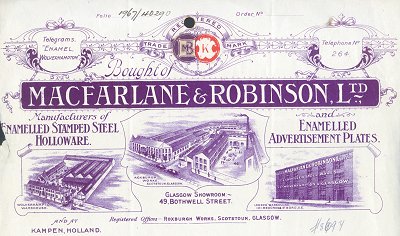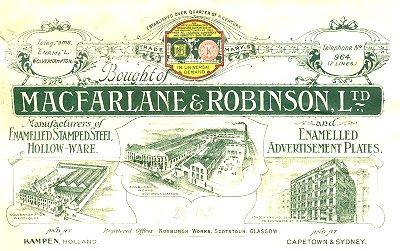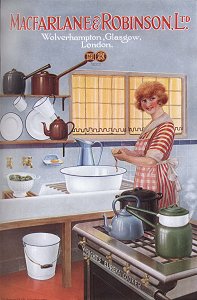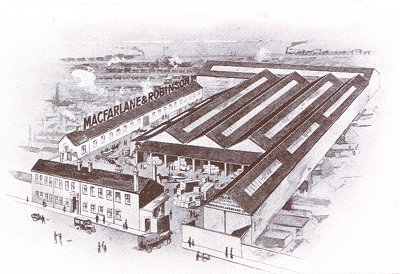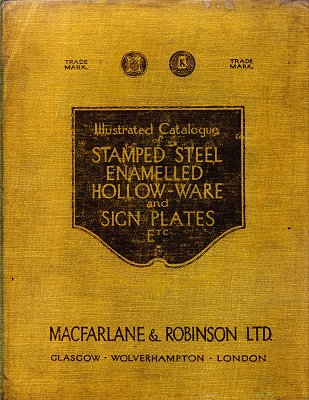MACFARLANE & ROBINSONstamped steel enamelled hollow-ware and sign plates etc..IntroductionMacfarlane and Robinson Ltd. were a Scottish company, based at the Roxborough Works, Scotstoun, Glasgow. They also had premises in Southwark Street and Red Cross Street, London. And, of course, they had premises in Wolverhampton, in Lower Stafford Street. George Peck remembers this company in Stafford Street and says this about them:
This letterhead, dated 1910, shows three of their factories, and their trade mark.
And this one, from 1917, is in a different colour scheme and has a different treatment of the trade marks at the top. Above them there now appears the words "Established over quarter of a century". This suggests that the company was founded not much before 1882.
In August 1910 this company issued a large catalogue of their goods. The catalogue was intended for wholesalers and retailers – the trade – not the ultimate consumer. A copy of this catalogue has come into the Curator’s possession and what follows is based on it.
Although the title page makes no reference to it and there is no picture of it, the catalogue devotes many pages to "Kampen Ware" which is "manufactured in our own Factory in Holland". (Whether this really means that they owned the factory or simply had their good made there, is not clear). Presumably this was actually in Kampen, a town on the eastern side of the Zuider Zee. All of this suggests that, while the firm probably started by making their own goods in Glasgow, when they expanded they set up a production facility in Wolverhampton, where goods were made as well as distributed. The Kampen factory seems to have produced very heavy, durable pieces. There is no way of telling what was made in Wolverhampton and what was made in Glasgow. The catalogue may even contain items brought in from other companies.
The range of items offered is enormous. The index gives about 300 different items. The great majority are in plain white enamel. But there is also a limited range with pale blue enamel on the outside and white enamel inside. The Kampen ware comes in chocolate/white, brown/grey, grey/grey, dark green/ivory, imitation earthenware/white. But in addition, and not from Kampen, and presumably either from Glasgow or Wolverhampton, there is a range of coloured and decorated holloware. But like many enamelling companies, they do not confine themselves to holloware. They also sell "hearth plates", in a wide range of colours and designs, which were fixed in front of the fire to catch sparks and cinders; wall plates, in many designs and colours which are in imitation of tiles and could be used for "lavatories, shops, etc."; number plates; and signs of all sorts. A look through the catalogue gives an idea of the enormous range of products an enamel company might produce; and of how universal enamelled ware was in homes and elsewhere. The purpose of the items and their designs also remind us how different were the ways we used to live. |
